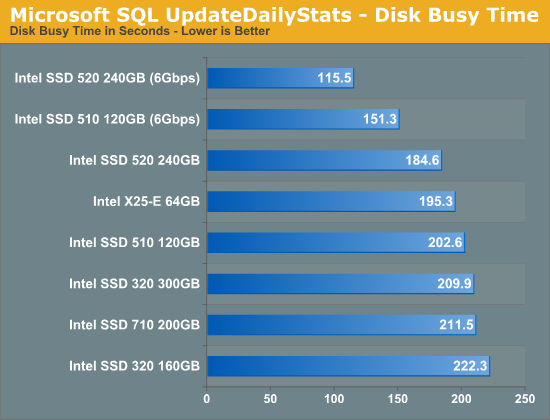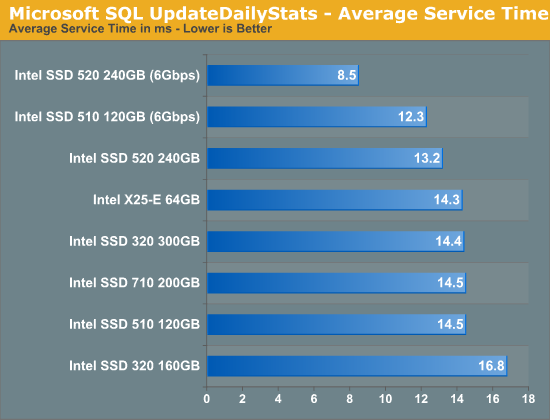A Look at Enterprise Performance of Intel SSDs
by Anand Lal Shimpi on February 8, 2012 6:36 PM EST- Posted in
- Storage
- IT Computing
- SSDs
- Intel
Enterprise Storage Bench - Microsoft SQL UpdateDailyStats
Our next two tests are taken from our own internal infrastructure. We do a lot of statistics tracking at AnandTech - we record traffic data to all articles as well as aggregate traffic for the entire site (including forums) on a daily basis. We also keep track of a running total of traffic for the month. Our first benchmark is a trace of the MS SQL process that does all of the daily and monthly stats processing for the site. We run this process once a day as it puts a fairly high load on our DB server. Then again, we don't have a beefy SSD array in there yet :)
The UpdateDailyStats procedure is mostly reads (3:1 ratio of GB reads to writes) with 431K read operations and 179K write ops. Average queue depth is 4.2 and only 34% of all IOs are issued at a queue depth of 1. The transfer size breakdown is as follows:
| AnandTech Enterprise Storage Bench MS SQL UpdateDaily Stats IO Breakdown | ||||
| IO Size | % of Total | |||
| 8KB | 21% | |||
| 64KB | 35% | |||
| 128KB | 35% | |||

Our SQL tests are much more dependent on sequential throughput and thus we really see some impressive gains from moving to a 6Gbps SATA interface. Among the 3Gbps results the Intel SSD 520 is now the top performer, followed once again by the X25-E. To be honest, most of these drives do perform the same as they bump into the limits of 3Gbps SATA.


Once again we see a huge reduction in service time from the Intel SSD 520 running on a 6Gbps interface. Even on a 3Gbps interface the 520 takes the lead while the bulk of the 3Gbps drives cluster together around 14.4ms. Note the tangible difference in performance between the 300GB and 160GB Intel SSD 320. The gap isn't purely because of additional NAND parallelism, the 300GB drive ends up with more effective spare area since the workload size doesn't scale up with drive capacity. What you're looking at here is the impact of spare area on performance.










55 Comments
View All Comments
Anand Lal Shimpi - Thursday, February 9, 2012 - link
Given enough spare area and a good enough SSD controller, TRIM isn't as important. It's still nice to have, but it's more of a concern on a drive where you're running much closer to capacity. Take the Intel SSD 710 in our benchmarks for example. We're putting a ~60GB data set on a 200GB drive with 320GB of NAND. With enough spare area it's possible to maintain low write amplification without TRIM. That's not to say that it's not valuable, but for the discussion today it's not at the top of the list.The beauty of covering the enterprise SSD space is that you avoid a lot of the high write amp controllers to begin with and extra spare area isn't unheard of. Try selling a 320GB consumer SSD with only 200GB of capacity and things look quite different :-P
Take care,
Anand
Stuka87 - Wednesday, February 8, 2012 - link
Great article Anand, I have been waiting for one like this. It will really come in handy to refer back to myself, and refer others too when they ask about SSD's in an enterprise environment.Iketh - Thursday, February 9, 2012 - link
Anand's nickname should be Magnitude or the OOM Guy.wrednys - Thursday, February 9, 2012 - link
What's going on with the media wear indicator on the first screenshot? 656%?Or is the data meaningless before the first E4 reset?
Kristian Vättö - Thursday, February 9, 2012 - link
Great article Anand, very interesting stuff!ssj3gohan - Thursday, February 9, 2012 - link
So... something I'm missing entirely in the article: what is your estimate of write amplification for the various drives? Like you said in another comment, typical workloads on Sandforce usually see WA < 1.0, while in this article it seems to be squarely above 1. Why is that, what is your estimate of the exact value and can you show us a workload that would actually benefit from Sandforce?This is very important, because with any reliability qualms out of the way the intel SSD 520 could be a solid recommendation for certain kinds of workloads. This article does not show any benefit to the 520.
Christopher29 - Thursday, February 9, 2012 - link
Members of this forum are testing (Anvil) SSDs with VERY extreme workloads. X25-V40GB (Intel drive) has already 685 TB WRITES ! This is WAY more than 5TB suggested by Intel. They also fill drives completely! This means that your 120GB SSDs (limited even to 100GB) could withstand almost 1 PB writes. One of their 40GB Intel 320 failed after writting 400TB!Corsair Force 3 120GB has already 1050TB writes! You shoul reconsider your assumptions, because it seems that those drives (and large ones especially) will last much longer.
Stats for today:
- Intel 320 40GB – 400TB (dead)
- Samsung 470 64GB – 490TB (dead)
- Crucial M4 64GB – 780TB (dead)
- Crucial M225 60GB – 840TB (dead)
- Corsair F40A - 210TB (dead)
- Mushkin Chronos Deluxe 60GB – 480TB (dead)
- Corsair Force 3 120GB – 1050TB (1 PB! and still going)
- Kingston SSDNow 40GB (X25-V) (34nm) - 640TB
SOURCE:
http://www.xtremesystems.org/forums/showthread.php...
Christopher29 - Thursday, February 9, 2012 - link
PS: And also interestingly Force 3 (that lasted longest) is exactly SF-2281 drive? So what is it in reality Anand, does this mean that SF do write less and therefore SSD last longer?Death666Angel - Thursday, February 9, 2012 - link
In every sentence, he commented how he was being conservative and that real numbers would likely be higher. However, given the sensitive nature of business data/storage needs, I think most of them are conservative and rightly so. The mentioned p/e cycles are also just estimates and likely vary a lot. Without anyone showing 1000 Force 3 drives doing over 1PB, that number is pretty much useless for such an article. :-)Kristian Vättö - Thursday, February 9, 2012 - link
I agree. In this case, it's better to underestimate than overestimate.